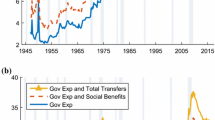Abstract
In a competitive and Walrasian stable world with two goods transfer paradoxes are very robust to endogenization (relating the size of the transfer to either the donor's or the recipient's GNP). Donor enrichment and/or recipient impoverishment occur in very general formulations of endogenization if and only if they occur in the model in which transfers are exogenous (as is usually assumed). Endogenization in practice will probably cause a dampening effect (smaller price and welfare changes than in the case of pure exogenous transfers).
Similar content being viewed by others
References
Berthélemy, J.-C. (1988): “The Transfer Paradox in a Non-Walrasian Context.”Weltwirtschaftliches Archiv 124: 420–434.
Bhagwati, J. N., Brecher, R. A., and Hatta, T. (1983): “The Generalized Theory of Transfers and Welfare: Bilateral Transfers in a Multilateral World.”American Economic Review 73: 606–618.
— (1985): “The Generalized Theory of Transfers and Welfare: Exogenous (Policy-imposed) and Endogenous (Transfer-induced) Distortions.”Quarterly Journal of Economics 100: 697–714.
Brakman, S., and Marrewijk, C. van (1989): “Transfer Problems in a Multicountry World: Endogenous, Optimal and Coordinated Aid.” Research Memorandum Nr. 297, Institute of Economic Research, University of Groningen.
Brecher, R. A., and Bhagwati, J. N. (1981): “Foreign Ownership and the Theory of Trade and Welfare.”Journal of Political Economy 89: 497–511.
—, (1982): “Immiserizing Transfers from Abroad.”Journal of International Economics 13: 353–364.
Gale, D. (1974): “Exchange Equilibrium and Coalitions: An Example.”Journal of Mathematical Economics 1: 63–66.
Ide, T., and Takayama, A. (1990): “Variable Returns to Scale and the Global Correspondence Principle in the Theory of International Trade.”Economics Letters 33: 301–308.
Kemp, M. C., and Shimomura, K. (1991): “‘Trade’ or ‘Aid’?” InTrade Policy and International Adjustment, edited by A. Takayama, M. Ohyama, and H. Ohta. New York: Academic Press.
Ohyama, M. (1974): “Tariffs and the Transfer Problem.”Keio Economic Studies 11: 29–45.
Samuelson, P. A. (1947):Foundations of Economics Analysis. Cambridge, MA: Harvard University Press.
— (1971): “On the Frail of Conventional Beliefs About the Transfer Problem.” InTrade, Balance of Payments and Growth, edited by J. N. Bhagwati et al. Amsterdam: North-Holland.
Turunen-Red, A. H., and Woodland, A. D. (1988): “On the Multilateral Transfer Problem.”Journal of International Economics 25: 249–269.
Author information
Authors and Affiliations
Rights and permissions
About this article
Cite this article
Brakman, S., van Marrewijk, C. A note on endogenous transfers. Zeitschr. f. Nationalökonomie 54, 171–178 (1991). https://doi.org/10.1007/BF01227084
Received:
Revised:
Issue Date:
DOI: https://doi.org/10.1007/BF01227084



